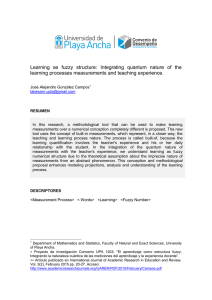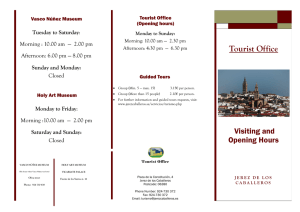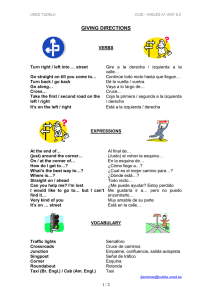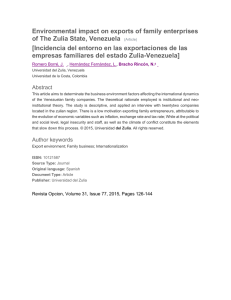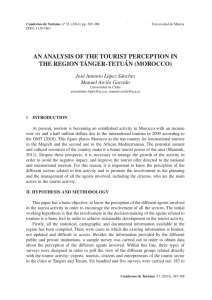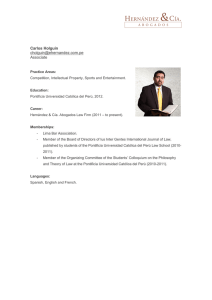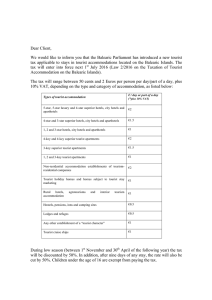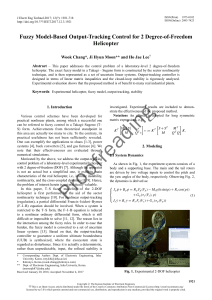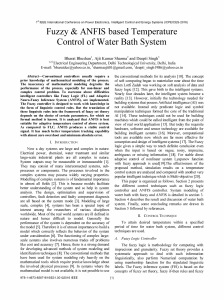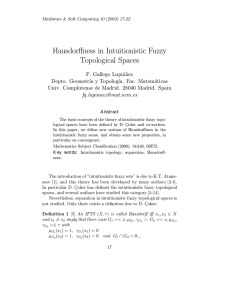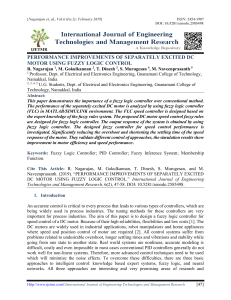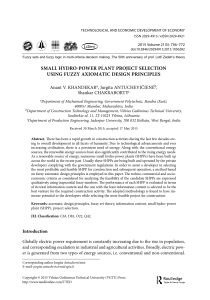analysis of tourist preferences: an innovative approach
Anuncio
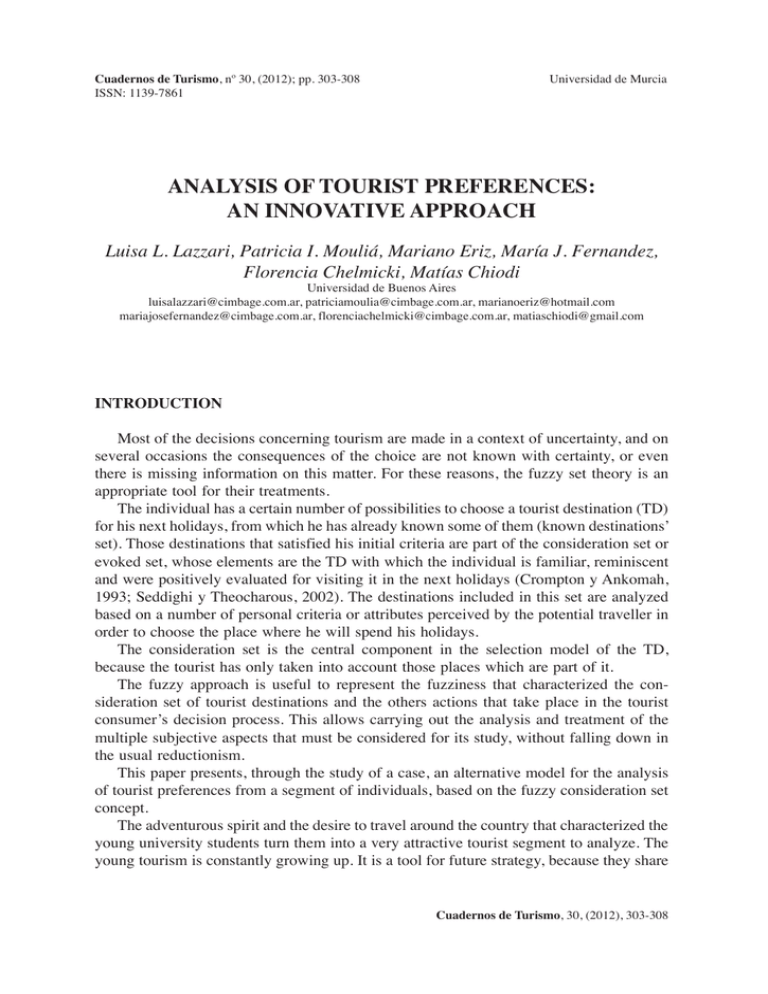
Cuadernos de Turismo, nº 30, (2012); pp. 303-308 ISSN: 1139-7861 Universidad de Murcia ANALYSIS OF TOURIST PREFERENCES: AN INNOVATIVE APPROACH Luisa L. Lazzari, Patricia I. Mouliá, Mariano Eriz, María J. Fernandez, Florencia Chelmicki, Matías Chiodi Universidad de Buenos Aires [email protected], [email protected], [email protected] [email protected], [email protected], [email protected] INTRODUCTION Most of the decisions concerning tourism are made in a context of uncertainty, and on several occasions the consequences of the choice are not known with certainty, or even there is missing information on this matter. For these reasons, the fuzzy set theory is an appropriate tool for their treatments. The individual has a certain number of possibilities to choose a tourist destination (TD) for his next holidays, from which he has already known some of them (known destinations’ set). Those destinations that satisfied his initial criteria are part of the consideration set or evoked set, whose elements are the TD with which the individual is familiar, reminiscent and were positively evaluated for visiting it in the next holidays (Crompton y Ankomah, 1993; Seddighi y Theocharous, 2002). The destinations included in this set are analyzed based on a number of personal criteria or attributes perceived by the potential traveller in order to choose the place where he will spend his holidays. The consideration set is the central component in the selection model of the TD, because the tourist has only taken into account those places which are part of it. The fuzzy approach is useful to represent the fuzziness that characterized the consideration set of tourist destinations and the others actions that take place in the tourist consumer’s decision process. This allows carrying out the analysis and treatment of the multiple subjective aspects that must be considered for its study, without falling down in the usual reductionism. This paper presents, through the study of a case, an alternative model for the analysis of tourist preferences from a segment of individuals, based on the fuzzy consideration set concept. The adventurous spirit and the desire to travel around the country that characterized the young university students turn them into a very attractive tourist segment to analyze. The young tourism is constantly growing up. It is a tool for future strategy, because they share Cuadernos de Turismo, 30, (2012), 303-308 304 L. L. LAZZARI, P. I. MOULIÁ, M. ERIZ, M. J. FERNANDEZ, F. CHELMICKI & M. CHIODI their experiences among their relatives and friends. The information used in this research was obtained from university young students in the winter holidays of 2009 in Argentina. PRELIMINARIES The fuzzy sets theory constitutes an effective way for the treatment of decision problems, where the information available is subjective and inaccurate (Zimmermann, 1996). This theory arises from the need to have any mathematical representation of usual objects which could not be adequately represented with the classic sets theory. In 1965 Lofti A. Zadeh, professor of the University of California, Berkeley, published the article named Fuzzy Sets and he is considered the founder of this theory. In a specific universe X, a fuzzy subset A is a function µA : X → [0,1] that assigns to each element from X a µA (x) value that belongs to the interval [0,1]. This is known as membership degree of x in A. The qualitative variables, which are inherent to human behaviour or some elements from the external environment, are hard to quantify objectively. In the case of tourism, is difficult for the individuals to represent with an exact numerical value the evaluation of various aspects of goods or services which they wish to acquire. Under those circumstances, the use of linguistics labels for expressing preferences turns to be more adequate. This approach to decision problems is based on the fuzzy sets theory and is known as linguistic approach. It applies when the variables involved are qualitative. The difference between a linguistic variable and a numerical one is that the values are not numbers there are words or sentences that belong to the natural language as well as to an artificial one (Zadeh, 1975). A linguistic model of decision making assumes the existence of an appropriate set of terms or labels in line with the problem, based on which the individuals express their preferences. ANALYSIS OF THE UNIVERSITY STUDENT’S TOURIST PREFERENCES In order to analyze the conformation and characteristics of the aggregate fuzzy consideration sets of the tourist destinations of university students for winter holidays 2009 from different regions of Argentina, in each instance of the research, a survey to 2300 students was done in the following universities in Argentina: Universidad de Buenos Aires (UBA); Universidad Nacional de Córdoba (UNC); Universidad Nacional de Misiones (UNaM); Universidad Nacional de Rosario (UNR) and Universidad Nacional de Tucumán (UNT). Only the responses of those students aged between 18 to 29 years old were taken into consideration. In all instances, the samples were determined by simple random sampling technique, stratified proportionally. The confidence level was 95.5%, the error of ± 5% and p=50%. It was added a 10% to the values obtained to offset the potential loss of information. For the preparation of the forms used in the survey was employed a linguistic scale with five values, in such a way that each polled student expressed his interest in visiting a tourist destination or the importance of a particular attribute by a label of the L set. Cuadernos de Turismo, 30, (2012), 303-308 ANALYSIS OF TOURIST PREFERENCES: AN INNOVATIVE APPROACH 305 L={very high (VH); high (H); medium (M); low (L); very low (VL)} It was considered as ‘the aggregate known destination referential set’ the one composed of all the destinations that were mentioned in the surveys for at least five students. Zero was assigned as the value of the membership function on the ‘aggregate fuzzy consideration set’ to those destinations that were chosen by less than the 10% of the sample. The information obtained in the survey was processed by a computing platform built on Java technology for fuzzy models, designed to have a high degree of scalability in order to handle very large data volumes, as well as perform real-time computations. The period of winter holidays of 2009 in Argentina was atypical and it was characterized by less movement of tourists due to the fear of spread of the influenza A (H1N1) and the global economic crisis. Nevertheless, the knowledge of the tourist preference of the young students in this period is useful for the public and private entities. The study was made during the months of April (first instance) and of June (second instance). The results of the first one include the following TD: Bariloche, Mendoza, Cataratas del Iguazú, Córdoba, El Calafate, Ushuaia, Salta, Buenos Aires, Puerto Madryn, San Martín de los Andes, Jujuy, Las Leñas, Mar del Plata, Tafí del Valle and Villa Carlos Paz. In the second one Mina Clavero was incorporated too. Bariloche obtained the highest consideration degree in both instances and all regions. Ushuaia, Mendoza, Cataratas del Iguazú, Jujuy, Salta and El Calafate were considered by students of the five universities in at least one instance, but with a degree less than 0,56. The overall preference of young people clearly leaned towards to Bariloche (0,85) followed by Mendoza (0,56). The other destinations have been considered with values smaller than 0,50. The composition of the fuzzy consideration sets of the tourist destinations has changed through time, either with regard to the place chosen, as the degrees of membership. The quantity of elements of the aggregate known destinations sets is not greater than 36 or less than 21, and the support cardinal of all aggregate fuzzy consideration sets obtained varies between 8 and 13. It is observed that the fuzziness of the aggregate fuzzy consideration sets of TD is low in all cases. Moreover, it remains constant or decreases in the second instance. The triangular representation of the cardinal of the consideration sets shows that the students consider in both instances between one and seven TD for visiting in their winter holidays, and the most frequent value is three or four. The final percentage of the total trips made by the young to the Argentina’s TD that belong to the consideration sets in each instance of the study is defined as a prediction of the model. According to the results for the studied period, it was 54,82% in the first instance and 55.42% in the second. As in this case, like in all analyzed, the prediction improved when the study was made closer to the decision making time. Furthermore, Córdoba, Mar del Plata, Mendoza, Bariloche, Tafí del Valle, Salta, Cataratas del Iguazú, Villa Carlos Paz, Las Leñas and Rosario received the most quantity of travellers and concentrate the 50,58% of all the trips made. Cuadernos de Turismo, 30, (2012), 303-308 306 L. L. LAZZARI, P. I. MOULIÁ, M. ERIZ, M. J. FERNANDEZ, F. CHELMICKI & M. CHIODI From these ten TD, nine of them were considered in both instances by the students of some university, and five for everyone in both instances. These are strong reasons for the travel agencies or tourist resorts to be interested in knowing the aggregate consideration sets of the potential visitors or of the segments they wish to capture. In every survey made it was asked about the attributes that were taken in consideration at the moment of choosing the possible destinations for spending the holidays and the importance that was assign to each one. The results obtained show that the sporting activities were valued in the aggregate as very high importance; adventure, weather, fun, human factor, geography of the place, price, security, calmness and nightlife with high importance; and with medium importance the cultural activities, the infrastructure, the distance to the chosen place and the transfer from the place of origin. CONCLUSIONS The importance of the consideration set lies on the fact that is a concept referred to a real selection process of a tourist destination, rather than a hypothetic situation and simplifies the tasks that the tourist consumer made in order to handle the complex decision problems. When a TD enters to the consideration set of a potential traveller, its possibilities to be chosen increase, in spite of the fact that it is not the favourite one. Not all the destinations that form the consideration set of an individual raised the same interest to be visited, because of the variety of attributes that were taken into account when they were selected and other factors which, in most cases, are subjective (Lazzari, 2010). For this reason it is possible to affirm that the TD considered acceptable to spend a holidays has different degree in the membership function of the set, so is adequate to analyze it as a fuzzy set. The membership degree of the fuzzy consideration set of a TD could be interpreted as the preference level or the degree of interesting in visiting that place. The aggregate consideration sets can also be useful to estimate the tourist demand to the destinations. The exchange of insights between individuals involved in the issues of tourist consumer behaviour, is characterized by the diversity of language attached of human interaction. The use of linguistic variables facilitates the convergence towards the same shared meanings. The tourist preferences study of the young people is awfully important for those tourist destinations that try to capture this growing market. ACKNOWLEDGMENTS The authors thank to the Agencia Nacional de Promoción Científica y Tecnológica del Ministerio de Ciencia, Tecnología e Innovación Productiva de la Argentina (PICT00383); to the Facultad de Ciencias Económicas of the Universidad de Buenos Aires where this project seats; to the Universidad de Buenos Aires (UBACyT proyect E018); to the Consejo Cuadernos de Turismo, 30, (2012), 303-308 ANALYSIS OF TOURIST PREFERENCES: AN INNOVATIVE APPROACH 307 Nacional de Investigaciones Científicas y Ténicas (CONICET); to the Coordinación de Investigaciones e Información Universitaria de la Secretaria de Políticas Universitarias del Ministerio de Educación and especially to the authorities, teachers and students of the different universities that participate in this study. REFERENCES CROMPTON, J.L.; ANKOMAH, P.K. (1993): «Choice set propositions in destination decisions». Annals of Tourism Research, vol. 20, pp. 461-476. ERIZ, M.; FERNÁNDEZ, M. J.; LAZZARI, L. (2005): «El conjunto de consideración de los destinos turísticos como un conjunto borroso». Cuadernos del CIMBAGE, vol. 7, pp. 79-101. HERRERA, F.; HERRERA-VIEDMA, E. (2000): «Linguistic decision analysis: steps for solving decision problems under linguistic information». Fuzzy Sets and Systems, vol. 115, pp. 67-82. KAUFMANN, A.; GIL ALUJA, J. (1987): Técnicas operativas de gestión para el tratamiento de la incertidumbre. Editorial Hispano Europea, Barcelona. LAZZARI, L.; MOULIÁ, P.; ERIZ, M. (2009): «An alternative operationalization of fuzzy consideration set». Application to tourism. Proceedings of 2009 International Fuzzy Systems Association World Congress / 2009 European Society for Fuzzy Logic and Technology Conference, pp.173-177. LAZZARI, L.; MOULIÁ, P.; ERIZ, M.; CHIODI, J.; FERNANDEZ, M. J.; CHIODI, M.; CHELMICKI F.; SICARDI, I.; PARMA, A.; ARCEO, C. (2010): Turismo joven en Argentina. Primer reporte de investigación. Facultad de Ciencias Económicas, UBA. Buenos Aires. LAZZARI, L. (2010): El comportamiento del consumidor desde una perspectiva fuzzy. Una aplicación a turismo. EDICON, Buenos Aires. SEDDIGHI, H.R.; THEOCHAROUS, A.L. (2002): «A model of tourism destination choice: a theoretical and empirical analysis». Tourism Management, vol. 23, pp.475487. TANAKA K., (1997): An Introduction to Fuzzy Logic for Practical Applications. SpringerVerlag, Nueva York. XU, Z. (2005): «Deviation measures of linguistic preference relations in group decision making». The International Journal of Management Science, vol. 33, pp. 249-254. XU, Z. (2006): «A note on linguistic hybrid arithmetic averaging operator in multiple attribute group decision making with linguistic information». Group Decision and Negotiation, vol. 15, pp. 593-604. XU, Z. (2008): «Linguistic aggregation operators: An overview». En: H. Bustince; F. Herrera; J. Montero (Eds.), Fuzzy Sets and Their Extensions: Representation, Aggregation and Models. Springer-Verlag, Berlin. YAGER, R.R. (1979): «On the measure of fuzziness and negation. Part I: Membership in the unit interval». International Journal of General Systems, vol. 5, pp. 221-229. YAGER, R.R.; FILEV, D. (1994): Essentials of Fuzzy Modeling and Control. John Wiley & Sons, Inc., Nueva York. Cuadernos de Turismo, 30, (2012), 303-308 308 L. L. LAZZARI, P. I. MOULIÁ, M. ERIZ, M. J. FERNANDEZ, F. CHELMICKI & M. CHIODI ZADEH, L.A. (1965): « Fuzzy sets ». Information and Control, vol. 8, pp.338-353. ZADEH, L.A. (1975): «The concept of a linguistic variable and its applications to approximate reasoning». Part I, Information Sciences, vol. 8, pp. 199-249. Part II, Information Sciences, vol. 8, pp.301-357. Part III, Information Sciences, vol. 9, pp. 43-80. ZIMMERMANN, H.J. (1996): Fuzzy set theory and its applications. Kluwer Academic Publishers, Boston. Cuadernos de Turismo, 30, (2012), 303-308
